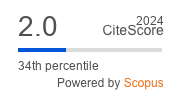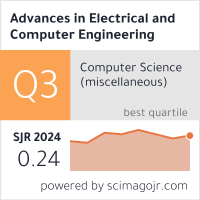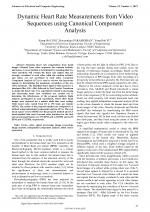| 3/2019 - 5 |
Dynamic Heart Rate Measurements from Video Sequences using Canonical Component AnalysisLING, S.-S. |
| Extra paper information in |
| Click to see author's profile in |
| Download PDF |
Author keywords
video signal processing, image processing, image analysis, independent component analysis, blind source separation
References keywords
rate(7), heart(7), biomedical(7), optics(6), video(5)
Blue keywords are present in both the references section and the paper title.
About this article
Date of Publication: 2019-08-31
Volume 19, Issue 3, Year 2019, On page(s): 41 - 48
ISSN: 1582-7445, e-ISSN: 1844-7600
Digital Object Identifier: 10.4316/AECE.2019.03005
Web of Science Accession Number: 000486574100005
SCOPUS ID: 85072202782
Abstract
Dynamic heart rate computation from facial images obtained from video sequences has random artifacts and noises. A novel method is formulated by assuming that two video durations will contain the heart rate signals that are strongly correlated to each other while the random artifacts and noises are not correlated to each other. Canonical Component Analysis (CCA) is used to recover the heart-rate signals by determining the maximum correlation of the two video durations. The identified heart signal is then passed to a bandpass filter (0.8 - 4Hz) followed by Fast Fourier Transform to obtain the heart rate. Two experiments related to increasing and decreasing heart rate variations are carried out to determine the effectiveness of the proposed method. Eight subjects participated in each experiment, where their facial images were captured for a minute while they were cycling. Their heart rates varied from 83 to 153 beats per minute (BPM). The results of the proposed method are compared to a method using independent component analysis (ICA). The root mean square errors (RMSE) for the proposed method and ICA based-method that used 5-second video duration for the first and second experiments are 3.70 BPM and 2.33 BPM and 14.36 BPM and 9.72 BPM, respectively. |
| References | | | Cited By «-- Click to see who has cited this paper |
| [1] D. Teichmann, C. Bruser, B. Eilebrecht, A. Abbas, N. Blanik, & S. Leonhardt, "Non-contact monitoring techniques - Principles and applications," In Engineering in Medicine and Biology Society (EMBC), 2012 Annual International Conference of the IEEE, IEEE, pp. 1302-1305, 2012. [CrossRef] [SCOPUS Times Cited 33] [2] Yu, Y. P. (2016). Dynamic heart rate estimation using facial images from video sequences/Yu Yong Poh (Doctoral dissertation, University of Malaya). [3] A. B. Hertzman, "The blood supply of various skin areas as estimated by the photoelectric plethysmograph," American Journal of Physiology, vol.124, no.2, pp. 328-340, 1938. [4] J. Weinman, A. Hayat, and G. Raviv, "Reflection photoplethysmography of arterial-blood-volume pulses," Medical and Biological Engineering and Computing, vol.15, no.1, pp. 22-31, 1977. [CrossRef] [SCOPUS Times Cited 55] [5] J. Allen, "Photoplethysmography and its application in clinical physiological measurement," Physiological measurement, vol.28, no.3, R1,2007 [CrossRef] [SCOPUS Times Cited 3179] [6] W. Verkruysse, L. O. Svaasand, and J. S. Nelson, "Remote plethysmographic imaging using ambient light," Opt. Express, vol. 16, no. 26, pp. 21434-21445, 2008. [CrossRef] [SCOPUS Times Cited 1421] [7] M. Z. Poh, D. J. McDuff, and R. W. Picard, "Non-contact, automated cardiac pulse measurements using video imaging and blind source separation," Optics Express, vol.18, no.10, pp.10762-10774 ,2010. [CrossRef] [SCOPUS Times Cited 1389] [8] A. A. Kamshilin, S. Miridonov, V. Teplov, R. Saarenheimo, & E. Nippolainen, "Photoplethysmographic imaging of high spatial resolution," Biomedical Optics Express, vol.2, no.4, pp. 996-1006, 2011. [CrossRef] [SCOPUS Times Cited 139] [9] M. Z. Poh, D. J. McDuff, and R. W. Picard, "Advancements in noncontact, multiparameter physiological measurements using a webcam," IEEE Transactions on Biomedical Engineering, vol.58, no.1, pp. 7-11, 2011. [CrossRef] [SCOPUS Times Cited 1300] [10] T. Pursche, J. Krajewski, and R. Moeller, "Video-based heart rate measurement from human faces," in Proceedings of IEEE International Conference on Consumer Electronics, IEEE, pp. 544-545, 2012. [CrossRef] [SCOPUS Times Cited 74] [11] S. Xu, L. Sun, and G. K. Rohde, "Robust efficient estimation of heart rate pulse from video," Biomedical optics express, vol.5, no.4, pp.1124-1135, 2014. [CrossRef] [SCOPUS Times Cited 75] [12] M. Kumar, A. Veeraraghavan, A. Sabharwal, "DistancePPG: Robust non-contact vital signs monitoring using a camera," Biomedical Optics Express, Vol.6, pp.1565-1588,2015. [CrossRef] [SCOPUS Times Cited 387] [13] D. R. Hardoon, S. Szedmak, J. Shawe-Taylor, "Canonical correlation analysis: An overview with application to learning methods," Neural computation, vol. 16, no.12, pp. 2639-2664, 2004. [CrossRef] [SCOPUS Times Cited 2673] [14] M. P. Tarvainen, P. O. Ranta-aho, and P. A. Karjalainen, "An advanced detrending method with application to HRV analysis," IEEE Transactions on Biomedical Engineering, vol. 49, no.2, pp. 172-175,2002. [CrossRef] [SCOPUS Times Cited 962] [15] M. Borga, H. Knutsson, "A Canonical Correlation Approach to Blind Source Separation," Linkoping University, Linkoping, Sweden, Technical Report LiU-IMT-EX-0062, 2001. [16] P. Viola, and M. Jones, "Rapid object detection using a boosted cascade of simple features," in Proceedings of the IEEE Computer Society Conference on Computer Vision and Pattern Recognition, 2001, IEEE, pp. I-511, 2001. [CrossRef] [17] M. Schonfelder, G. Hinterseher, P. Peter, & P. Spitzenpfeil, "Scientific comparison of different online heart rate monitoring systems." International Journal of Telemedicine and Applications, vol.2011, 6, 2011. [CrossRef] [SCOPUS Times Cited 41] [18] M. B. Wallen, D. Hasson, T. Theorell, B. Canlon, & W. Osika, "Possibilities and limitations of the polar RS800 in measuring heart rate variability at rest," European Journal of Applied Physiology, vol.112, no.3, pp.1153-1165, 2012. [CrossRef] [SCOPUS Times Cited 109] [19] Y. P. Yu, P. Raveendran, C. L. Lim. "Dynamic heart rate measurements from video sequences." Biomedical Optics Express, 6(7), pp.2466-2480, 2015. [CrossRef] [SCOPUS Times Cited 21] [20] Y. P. Yu, P. Raveendran, C. L. Lim, B. H. Kwan, "Dynamic heart rate estimation using principal component analysis." Biomedical Optics Express, 6(11), pp.4610-4618, 2015. [CrossRef] [SCOPUS Times Cited 17] Web of Science® Citations for all references: 0 SCOPUS® Citations for all references: 11,875 TCR Web of Science® Average Citations per reference: 0 SCOPUS® Average Citations per reference: 565 ACR TCR = Total Citations for References / ACR = Average Citations per Reference We introduced in 2010 - for the first time in scientific publishing, the term "References Weight", as a quantitative indication of the quality ... Read more Citations for references updated on 2025-07-01 11:28 in 114 seconds. Note1: Web of Science® is a registered trademark of Clarivate Analytics. Note2: SCOPUS® is a registered trademark of Elsevier B.V. Disclaimer: All queries to the respective databases were made by using the DOI record of every reference (where available). Due to technical problems beyond our control, the information is not always accurate. Please use the CrossRef link to visit the respective publisher site. |
Faculty of Electrical Engineering and Computer Science
Stefan cel Mare University of Suceava, Romania
All rights reserved: Advances in Electrical and Computer Engineering is a registered trademark of the Stefan cel Mare University of Suceava. No part of this publication may be reproduced, stored in a retrieval system, photocopied, recorded or archived, without the written permission from the Editor. When authors submit their papers for publication, they agree that the copyright for their article be transferred to the Faculty of Electrical Engineering and Computer Science, Stefan cel Mare University of Suceava, Romania, if and only if the articles are accepted for publication. The copyright covers the exclusive rights to reproduce and distribute the article, including reprints and translations.
Permission for other use: The copyright owner's consent does not extend to copying for general distribution, for promotion, for creating new works, or for resale. Specific written permission must be obtained from the Editor for such copying. Direct linking to files hosted on this website is strictly prohibited.
Disclaimer: Whilst every effort is made by the publishers and editorial board to see that no inaccurate or misleading data, opinions or statements appear in this journal, they wish to make it clear that all information and opinions formulated in the articles, as well as linguistic accuracy, are the sole responsibility of the author.



